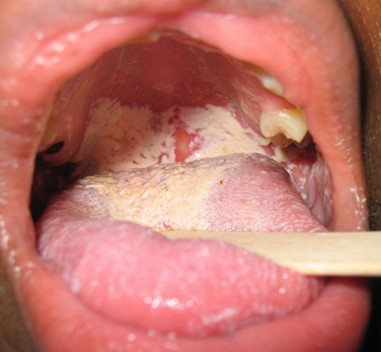A nurse is caring for a school-age child who has a systemic disorder and is
receiving antibiotics, immunosuppressants, and corticosteroids. Both of the child's parents have a smoking history.
The child reports soreness in his mouth and refuses to eat.
Inspection of his mouth reveals a white, milky plaque that does not come off with
rubbing.
The nurse should suspect which of the following conditions?
Dermatitis
Candidiasis
Herpes simplex
Squamous cell carcinoma.
The Correct Answer is B
The nurse should suspect candidiasis, also known as oral thrush.
Candidiasis is a fungal infection that can occur in the mouth and is characterized by the presence of a white, milky plaque that does not come off with rubbing.
The child’s use of antibiotics, immunosuppressants, and corticosteroids can increase the risk of developing candidiasis.
Choice A is incorrect because dermatitis is an inflammation of the skin and
would not present as a white plaque in the mouth.
Choice C is incorrect because herpes simplex typically presents as painful blisters or sores in the mouth.
Choice D is incorrect because squamous cell carcinoma typically presents as a firm, painless growth, or ulcer in the mouth.

Nursing Test Bank
Naxlex Comprehensive Predictor Exams
Related Questions
Correct Answer is A
Explanation
The correct answer is Choice A.
Choice A rationale: Encouraging the infant to stand in the crib while in a cast for developmental dysplasia of the hip (DDH) supports gross motor development and maintains neuromuscular stimulation. Standing promotes proprioceptive input, strengthens postural muscles, and supports bone mineralization through weight-bearing. Infants in hip spica casts or orthotic devices can safely stand with supervision, preserving developmental milestones. Normal serum calcium ranges from 8.5 to 10.5 mg/dL, and mechanical loading enhances osteoblastic activity and skeletal growth.
Choice B rationale: While electronic toys offer sensory stimulation, they do not adequately support gross motor development in infants with DDH. At 10 months, infants require opportunities for vertical positioning and weight-bearing to stimulate vestibular and musculoskeletal systems. Passive play with electronic toys may delay motor milestones such as cruising and standing. Developmental progress depends on integrated sensory-motor experiences, and reliance on sedentary toys may limit engagement of core and lower limb musculature.
Choice C rationale: Latex balloons pose a significant safety hazard due to the risk of aspiration and suffocation. When burst, latex fragments can occlude the airway, especially in infants with underdeveloped protective reflexes. The tracheal diameter in infants averages 4 to 5 mm, making obstruction by balloon fragments potentially fatal. Additionally, latex exposure may trigger allergic reactions, particularly in atopic individuals. The American Academy of Pediatrics strongly advises against latex balloon use in children under 8 years.
Choice D rationale: Prompt diaper changes are essential for skin integrity, especially under a cast where moisture retention can lead to maceration and infection. However, this action does not directly promote growth and development. It is a hygiene measure that prevents irritant contact dermatitis and secondary infections such as Candida albicans. Normal skin pH ranges from 4.5 to 5.5, and prolonged exposure to urine and feces elevates pH, disrupting the acid mantle. While necessary, it lacks developmental stimulation.
Correct Answer is D
Explanation
a.Talcum powder is not recommended for use with infants because it can be inhaled, potentially causing respiratory problems. Instead, a barrier cream or ointment (such as zinc oxide or petroleum jelly) should be used to protect the skin from moisture and irritants.
b.While cloth diapers can be less irritating than some disposable diapers, they may not be as effective at keeping the skin dry. The priority is to keep the area dry and clean, regardless of the type of diaper used. Super-absorbent disposable diapers are often recommended because they can help keep the skin dry.
c.Exposing the skin to hot air can cause burns and further irritation. Instead, allowing the skin to air dry naturally (without the use of hot air) during diaper changes can be beneficial.
d.A moisturizer creates a barrier between the skin and irritants like urine and stool.Wiping with a moisturizer can minimize friction during cleaning, which can be uncomfortable for the baby and further irritate the skin.Some moisturizers can help soothe and hydrate the inflamed skin, promoting healing.
Whether you are a student looking to ace your exams or a practicing nurse seeking to enhance your expertise , our nursing education contents will empower you with the confidence and competence to make a difference in the lives of patients and become a respected leader in the healthcare field.
Visit Naxlex, invest in your future and unlock endless possibilities with our unparalleled nursing education contents today
Report Wrong Answer on the Current Question
Do you disagree with the answer? If yes, what is your expected answer? Explain.
Kindly be descriptive with the issue you are facing.
